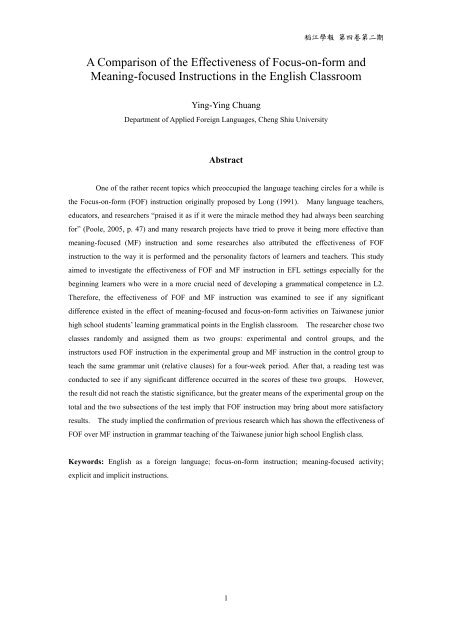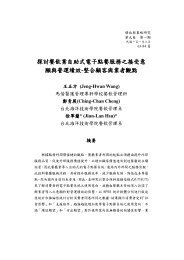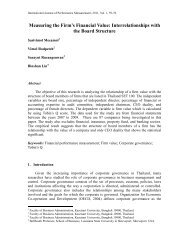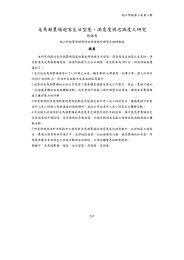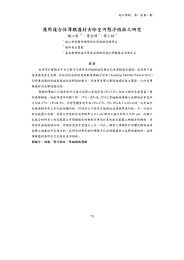A Comparison of the Effectiveness of Focus-on-form and Meaning ...
A Comparison of the Effectiveness of Focus-on-form and Meaning ...
A Comparison of the Effectiveness of Focus-on-form and Meaning ...
Create successful ePaper yourself
Turn your PDF publications into a flip-book with our unique Google optimized e-Paper software.
稻 江 學 報 第 四 卷 第 二 期<br />
A <str<strong>on</strong>g>Comparis<strong>on</strong></str<strong>on</strong>g> <str<strong>on</strong>g>of</str<strong>on</strong>g> <str<strong>on</strong>g>the</str<strong>on</strong>g> <str<strong>on</strong>g>Effectiveness</str<strong>on</strong>g> <str<strong>on</strong>g>of</str<strong>on</strong>g> <str<strong>on</strong>g>Focus</str<strong>on</strong>g>-<strong>on</strong>-<strong>form</strong> <strong>and</strong><br />
<strong>Meaning</strong>-focused Instructi<strong>on</strong>s in <str<strong>on</strong>g>the</str<strong>on</strong>g> English Classroom<br />
Ying-Ying Chuang<br />
Department <str<strong>on</strong>g>of</str<strong>on</strong>g> Applied Foreign Languages, Cheng Shiu University<br />
Abstract<br />
One <str<strong>on</strong>g>of</str<strong>on</strong>g> <str<strong>on</strong>g>the</str<strong>on</strong>g> ra<str<strong>on</strong>g>the</str<strong>on</strong>g>r recent topics which preoccupied <str<strong>on</strong>g>the</str<strong>on</strong>g> language teaching circles for a while is<br />
<str<strong>on</strong>g>the</str<strong>on</strong>g> <str<strong>on</strong>g>Focus</str<strong>on</strong>g>-<strong>on</strong>-<strong>form</strong> (FOF) instructi<strong>on</strong> originally proposed by L<strong>on</strong>g (1991). Many language teachers,<br />
educators, <strong>and</strong> researchers “praised it as if it were <str<strong>on</strong>g>the</str<strong>on</strong>g> miracle method <str<strong>on</strong>g>the</str<strong>on</strong>g>y had always been searching<br />
for” (Poole, 2005, p. 47) <strong>and</strong> many research projects have tried to prove it being more effective than<br />
meaning-focused (MF) instructi<strong>on</strong> <strong>and</strong> some researches also attributed <str<strong>on</strong>g>the</str<strong>on</strong>g> effectiveness <str<strong>on</strong>g>of</str<strong>on</strong>g> FOF<br />
instructi<strong>on</strong> to <str<strong>on</strong>g>the</str<strong>on</strong>g> way it is per<strong>form</strong>ed <strong>and</strong> <str<strong>on</strong>g>the</str<strong>on</strong>g> pers<strong>on</strong>ality factors <str<strong>on</strong>g>of</str<strong>on</strong>g> learners <strong>and</strong> teachers. This study<br />
aimed to investigate <str<strong>on</strong>g>the</str<strong>on</strong>g> effectiveness <str<strong>on</strong>g>of</str<strong>on</strong>g> FOF <strong>and</strong> MF instructi<strong>on</strong> in EFL settings especially for <str<strong>on</strong>g>the</str<strong>on</strong>g><br />
beginning learners who were in a more crucial need <str<strong>on</strong>g>of</str<strong>on</strong>g> developing a grammatical competence in L2.<br />
Therefore, <str<strong>on</strong>g>the</str<strong>on</strong>g> effectiveness <str<strong>on</strong>g>of</str<strong>on</strong>g> FOF <strong>and</strong> MF instructi<strong>on</strong> was examined to see if any significant<br />
difference existed in <str<strong>on</strong>g>the</str<strong>on</strong>g> effect <str<strong>on</strong>g>of</str<strong>on</strong>g> meaning-focused <strong>and</strong> focus-<strong>on</strong>-<strong>form</strong> activities <strong>on</strong> Taiwanese junior<br />
high school students’ learning grammatical points in <str<strong>on</strong>g>the</str<strong>on</strong>g> English classroom. The researcher chose two<br />
classes r<strong>and</strong>omly <strong>and</strong> assigned <str<strong>on</strong>g>the</str<strong>on</strong>g>m as two groups: experimental <strong>and</strong> c<strong>on</strong>trol groups, <strong>and</strong> <str<strong>on</strong>g>the</str<strong>on</strong>g><br />
instructors used FOF instructi<strong>on</strong> in <str<strong>on</strong>g>the</str<strong>on</strong>g> experimental group <strong>and</strong> MF instructi<strong>on</strong> in <str<strong>on</strong>g>the</str<strong>on</strong>g> c<strong>on</strong>trol group to<br />
teach <str<strong>on</strong>g>the</str<strong>on</strong>g> same grammar unit (relative clauses) for a four-week period. After that, a reading test was<br />
c<strong>on</strong>ducted to see if any significant difference occurred in <str<strong>on</strong>g>the</str<strong>on</strong>g> scores <str<strong>on</strong>g>of</str<strong>on</strong>g> <str<strong>on</strong>g>the</str<strong>on</strong>g>se two groups. However,<br />
<str<strong>on</strong>g>the</str<strong>on</strong>g> result did not reach <str<strong>on</strong>g>the</str<strong>on</strong>g> statistic significance, but <str<strong>on</strong>g>the</str<strong>on</strong>g> greater means <str<strong>on</strong>g>of</str<strong>on</strong>g> <str<strong>on</strong>g>the</str<strong>on</strong>g> experimental group <strong>on</strong> <str<strong>on</strong>g>the</str<strong>on</strong>g><br />
total <strong>and</strong> <str<strong>on</strong>g>the</str<strong>on</strong>g> two subsecti<strong>on</strong>s <str<strong>on</strong>g>of</str<strong>on</strong>g> <str<strong>on</strong>g>the</str<strong>on</strong>g> test imply that FOF instructi<strong>on</strong> may bring about more satisfactory<br />
results. The study implied <str<strong>on</strong>g>the</str<strong>on</strong>g> c<strong>on</strong>firmati<strong>on</strong> <str<strong>on</strong>g>of</str<strong>on</strong>g> previous research which has shown <str<strong>on</strong>g>the</str<strong>on</strong>g> effectiveness <str<strong>on</strong>g>of</str<strong>on</strong>g><br />
FOF over MF instructi<strong>on</strong> in grammar teaching <str<strong>on</strong>g>of</str<strong>on</strong>g> <str<strong>on</strong>g>the</str<strong>on</strong>g> Taiwanese junior high school English class.<br />
Keywords: English as a foreign language; focus-<strong>on</strong>-<strong>form</strong> instructi<strong>on</strong>; meaning-focused activity;<br />
explicit <strong>and</strong> implicit instructi<strong>on</strong>s.<br />
1
稻 江 學 報 第 四 卷 第 二 期<br />
比 較 「 形 式 為 中 心 」 與 「 意 義 為 中 心 」 英 語 教 學 法 於 國 中 生<br />
英 語 課 堂 的 文 法 教 學 成 效 之 研 究<br />
莊 媖 纓<br />
正 修 科 技 大 學 應 用 外 語 系<br />
摘 要<br />
「 形 式 為 中 心 」 教 學 法 是 一 種 在 最 近 幾 年 受 到 注 意 的 新 形 態 外 語 教 學 模 式 , 它 得 到 許 多<br />
教 師 及 研 究 學 者 的 重 視 並 推 崇 其 理 念 。 從 許 多 國 外 的 研 究 報 告 中 , 幾 乎 都 可 獲 得 證 實 : 在 英 語 課<br />
堂 教 學 過 程 中 及 學 生 的 學 習 效 果 中 , 它 比 起 「 意 義 為 中 心 」 教 學 法 , 更 來 得 有 效 果 。 本 研 究 的 目<br />
的 , 是 要 就 實 施 「 形 式 為 中 心 」 及 「 意 義 為 中 心 」 教 學 法 於 臺 灣 國 中 一 年 級 學 生 的 英 語 課 堂 , 尤<br />
其 是 在 英 語 初 學 者 的 文 法 學 習 成 效 中 , 來 比 較 這 兩 種 教 學 法 是 否 有 達 到 顯 著 差 異 , 及 是 否 與 國 外<br />
研 究 報 告 有 相 似 之 結 果 。 筆 者 將 兩 班 學 生 各 分 配 為 實 驗 組 及 對 照 組 , 兩 班 分 別 施 以 不 同 教 學 法 ,<br />
在 四 星 期 的 期 間 來 教 授 同 樣 的 文 法 單 元 ( 關 係 子 句 ), 最 後 再 以 初 級 英 檢 題 目 之 閱 讀 測 驗 來 評 量 兩<br />
組 學 生 的 學 習 成 效 。 本 研 究 所 得 到 的 結 論 , 由 兩 組 學 生 的 英 語 閱 讀 評 量 測 驗 成 績 中 , 雖 未 達 統 計<br />
學 上 的 顯 著 差 異 , 但 較 高 的 平 均 值 仍 顯 示 「 形 式 為 中 心 」 教 學 法 在 國 中 生 英 語 課 堂 的 文 法 教 學 上 ,<br />
比 「 意 義 為 中 心 」 之 教 學 法 是 有 更 好 的 學 習 效 果 。<br />
關 鍵 字 : 英 語 學 習 ; 形 式 為 中 心 教 學 法 ; 意 義 為 中 心 教 學 法 ; 演 繹 法 ; 文 法 規 納 教 學 法 。<br />
2
稻 江 學 報 第 四 卷 第 二 期<br />
I. Introducti<strong>on</strong><br />
Teaching <strong>and</strong> learning a foreign language is influenced by a plethora <str<strong>on</strong>g>of</str<strong>on</strong>g> factors. One <str<strong>on</strong>g>of</str<strong>on</strong>g> <str<strong>on</strong>g>the</str<strong>on</strong>g><br />
major c<strong>on</strong>troversies in learning especially <str<strong>on</strong>g>the</str<strong>on</strong>g> syntactic comp<strong>on</strong>ent <str<strong>on</strong>g>of</str<strong>on</strong>g> <str<strong>on</strong>g>the</str<strong>on</strong>g> language is over <str<strong>on</strong>g>the</str<strong>on</strong>g> explicit<br />
(direct) or implicit (indirect) instructi<strong>on</strong> <str<strong>on</strong>g>of</str<strong>on</strong>g> grammatical rules. In fact, <str<strong>on</strong>g>the</str<strong>on</strong>g> extent to which knowledge<br />
obtained from explicit instructi<strong>on</strong> could over time become part <str<strong>on</strong>g>of</str<strong>on</strong>g> a foreign language learner's<br />
underlying system <str<strong>on</strong>g>of</str<strong>on</strong>g> implicit knowledge <strong>and</strong> <str<strong>on</strong>g>the</str<strong>on</strong>g>refore available for sp<strong>on</strong>taneous language producti<strong>on</strong><br />
was still an open questi<strong>on</strong> (Lyster, 2004). While <strong>on</strong> <str<strong>on</strong>g>the</str<strong>on</strong>g> assumpti<strong>on</strong> that foreign language learning was<br />
like first language acquisiti<strong>on</strong>, experiential approaches to L2 acquisiti<strong>on</strong> proposed that language<br />
developed principally out <str<strong>on</strong>g>of</str<strong>on</strong>g> experience with real-life communicati<strong>on</strong> <strong>and</strong> pure meaningful activities, as<br />
Nassaji (1999) maintains that many sec<strong>on</strong>d language acquisiti<strong>on</strong> researchers believed in <str<strong>on</strong>g>the</str<strong>on</strong>g> inadequacy<br />
<str<strong>on</strong>g>of</str<strong>on</strong>g> pure meaning-focused activities in which <str<strong>on</strong>g>the</str<strong>on</strong>g> learners exposure to language for developing L2<br />
competence.<br />
However, L<strong>on</strong>g (1983) questi<strong>on</strong>ed about Krashen’s (1985) <strong>and</strong> Prabh’s (1987)<br />
meaning-focused positi<strong>on</strong>, <strong>and</strong> later he argued that instead <str<strong>on</strong>g>of</str<strong>on</strong>g> more focus <strong>on</strong> message-based activities.<br />
There should be some room for referring to <str<strong>on</strong>g>the</str<strong>on</strong>g> problems that language learners have with linguistic<br />
<strong>form</strong>s. This positi<strong>on</strong> was known as ‘focus-<strong>on</strong>-<strong>form</strong>’ positi<strong>on</strong>, <strong>and</strong> it had been widely noticed by many<br />
researchers (e.g. Nassaji, 2000; Muranoi, 2000; Ellis, Badturkmen & Loewen 2001; Burgess &<br />
E<str<strong>on</strong>g>the</str<strong>on</strong>g>ringt<strong>on</strong>, 2002; Basturkmen, Loewen & Ellis, 2002; Chan & Li, 2002, Ellis, Basturkmen & Loewen,<br />
2002; Sheen, 2002; Loewen, 2003; Lyster, 2004; Poole, 2005). Poole (2005) said that it presented “a<br />
source <str<strong>on</strong>g>of</str<strong>on</strong>g> great enthusiasm for English language teachers <strong>and</strong> researchers so much so that many have<br />
praised it as if it were <str<strong>on</strong>g>the</str<strong>on</strong>g> miracle method <str<strong>on</strong>g>the</str<strong>on</strong>g>y had always been searching for” (p. 47). Therefore, this<br />
study aims to investigate <str<strong>on</strong>g>the</str<strong>on</strong>g> effectiveness <str<strong>on</strong>g>of</str<strong>on</strong>g> focus-<strong>on</strong>-<strong>form</strong> <strong>and</strong> meaning-focused instructi<strong>on</strong>, <strong>and</strong> to<br />
see if any significant difference exists in <str<strong>on</strong>g>the</str<strong>on</strong>g> effect <str<strong>on</strong>g>of</str<strong>on</strong>g> meaning-focused <strong>and</strong> focus-<strong>on</strong>-<strong>form</strong> activities <strong>on</strong><br />
Taiwanese junior high school students’ learning grammatical points in <str<strong>on</strong>g>the</str<strong>on</strong>g> EFL classroom.<br />
II. Review <str<strong>on</strong>g>of</str<strong>on</strong>g> Literature<br />
2.1. Theoretical Foundati<strong>on</strong>s <str<strong>on</strong>g>of</str<strong>on</strong>g> <str<strong>on</strong>g>Focus</str<strong>on</strong>g> <strong>on</strong> Form<br />
Researchers endorsing focus <strong>on</strong> <strong>form</strong> positi<strong>on</strong> in language instructi<strong>on</strong> usually justify <str<strong>on</strong>g>the</str<strong>on</strong>g>ir<br />
positi<strong>on</strong> by resorting to interactive <strong>and</strong> cognitive epistemological perspectives <strong>on</strong> language acquisiti<strong>on</strong>.<br />
2.1.1. Interactive View<br />
Interactive or interacti<strong>on</strong>ist approaches to sec<strong>on</strong>d language acquisiti<strong>on</strong>, which were based <strong>on</strong><br />
functi<strong>on</strong>al views <str<strong>on</strong>g>of</str<strong>on</strong>g> language as a symbolic system that developed from communicative needs (Gass,<br />
2003), focus <strong>on</strong> <str<strong>on</strong>g>the</str<strong>on</strong>g> relati<strong>on</strong>ship between learner internal <strong>and</strong> external processes in L2 acquisiti<strong>on</strong><br />
(Norris <strong>and</strong> Ortega, 2003). L<strong>on</strong>g’s (1991) interacti<strong>on</strong> hypo<str<strong>on</strong>g>the</str<strong>on</strong>g>sis held that negotiati<strong>on</strong> <str<strong>on</strong>g>of</str<strong>on</strong>g> meaning was<br />
particularly beneficial for learning in sec<strong>on</strong>d language because it involved learners in having to pay<br />
closer attenti<strong>on</strong> to linguistic <strong>form</strong>s when <str<strong>on</strong>g>the</str<strong>on</strong>g>re was a breakdown in communicati<strong>on</strong>. In his account,<br />
3
稻 江 學 報 第 四 卷 第 二 期<br />
during meaningful interacti<strong>on</strong> <str<strong>on</strong>g>the</str<strong>on</strong>g> learners used different communicative strategies, ranging from<br />
modifying <strong>and</strong> adjusting input to using facilitative strategies such as requests for clarificati<strong>on</strong>, requests<br />
for repetiti<strong>on</strong>, <strong>and</strong> comprehensi<strong>on</strong> checks (Nassaji, 1999). Referring to Schmidt’s (1990) emphasis <strong>on</strong><br />
<str<strong>on</strong>g>the</str<strong>on</strong>g> role <str<strong>on</strong>g>of</str<strong>on</strong>g> attenti<strong>on</strong> in learning, Gass (2003) maintained that “it is through interacti<strong>on</strong> (e.g. negotiati<strong>on</strong>,<br />
recasts) that a learner’s attenti<strong>on</strong> is focused <strong>on</strong> specific part <str<strong>on</strong>g>of</str<strong>on</strong>g> <str<strong>on</strong>g>the</str<strong>on</strong>g> language, especially <strong>on</strong> those<br />
mismatches between target language <strong>form</strong>s <strong>and</strong> learner-language <strong>form</strong>s” (p. 244). While this<br />
negotiati<strong>on</strong> <str<strong>on</strong>g>of</str<strong>on</strong>g> meaning took place in everyday communicati<strong>on</strong>, L<strong>on</strong>g (1991) argued that it can also<br />
occur in <str<strong>on</strong>g>the</str<strong>on</strong>g> classroom <strong>and</strong> identifies this as focus- <strong>on</strong>-<strong>form</strong>. In additi<strong>on</strong>, Lyster (2004) pointed out<br />
that resolving communicati<strong>on</strong> breakdowns through negotiati<strong>on</strong> for meaning involved <str<strong>on</strong>g>the</str<strong>on</strong>g> use <str<strong>on</strong>g>of</str<strong>on</strong>g><br />
communicati<strong>on</strong> strategies; <str<strong>on</strong>g>the</str<strong>on</strong>g>refore, did not aim to effect changes in a learner’s underlying<br />
inter-language system. Thus, he c<strong>on</strong>cluded, <str<strong>on</strong>g>the</str<strong>on</strong>g> interacti<strong>on</strong> hypo<str<strong>on</strong>g>the</str<strong>on</strong>g>sis was “an unlikely c<strong>and</strong>idate for<br />
explaining instructed L2 development, especially in classroom c<strong>on</strong>texts where mutual comprehensi<strong>on</strong><br />
<str<strong>on</strong>g>of</str<strong>on</strong>g> inter-language <strong>form</strong>s reduces <str<strong>on</strong>g>the</str<strong>on</strong>g> need to negotiate for meaning” (2004, p. 323).<br />
2.1.2. Cognitive View<br />
The <str<strong>on</strong>g>the</str<strong>on</strong>g>oretical foundati<strong>on</strong> <str<strong>on</strong>g>of</str<strong>on</strong>g> focus-<strong>on</strong>-<strong>form</strong> positi<strong>on</strong> in cognitive views was justified by<br />
McLaughlin (1987) <strong>and</strong> Skehan (1998). According to McLaughlin (1987), learning an L2 involved<br />
two cognitive processes: automatizati<strong>on</strong> <strong>and</strong> restructuring. ‘Automatizati<strong>on</strong>’ refers to quick <strong>and</strong><br />
effortless resp<strong>on</strong>ses to linguistic stimuli, initiated with c<strong>on</strong>trolled processes which <str<strong>on</strong>g>the</str<strong>on</strong>g>n turn into<br />
routinized <strong>and</strong> automatized resp<strong>on</strong>ses through subsequent practice. ‘Restructuring’ has to do with<br />
sudden moments <str<strong>on</strong>g>of</str<strong>on</strong>g> insight <strong>and</strong> refers to <str<strong>on</strong>g>the</str<strong>on</strong>g> time when <str<strong>on</strong>g>the</str<strong>on</strong>g> learner underst<strong>and</strong>s <str<strong>on</strong>g>the</str<strong>on</strong>g> input in a different<br />
way. It is characterized as a total, disc<strong>on</strong>tinuous, or qualitative change in an already existing cognitive<br />
patterning. In restructuring view, L2 development not <strong>on</strong>ly involved moving from c<strong>on</strong>trolled to<br />
automatized processes, but also it was a c<strong>on</strong>stant process <str<strong>on</strong>g>of</str<strong>on</strong>g> reorganizing, refining, <strong>and</strong> integrating new<br />
in<strong>form</strong>ati<strong>on</strong> into previous internal representati<strong>on</strong>s (Nassaji, 1999, 2000; Lyster, 2004). Central to<br />
restructuring process was attenti<strong>on</strong> to <strong>form</strong>, <strong>and</strong> it argued that restructuring <str<strong>on</strong>g>of</str<strong>on</strong>g> grammar principally took<br />
place when learners attended to <strong>and</strong> notice features in input <strong>and</strong> <str<strong>on</strong>g>the</str<strong>on</strong>g>re was no learning without attenti<strong>on</strong><br />
(Schmidt, 1990; Nassaji, 1999; Gass, 2003).<br />
In Skehan’s (1998) in<strong>form</strong>ati<strong>on</strong> processing model, <str<strong>on</strong>g>the</str<strong>on</strong>g> learner’s c<strong>on</strong>scious awareness <str<strong>on</strong>g>of</str<strong>on</strong>g> rule<br />
based representati<strong>on</strong>s was identified as a key factor in inter-language development. In this model,<br />
noticing plays a central role in c<strong>on</strong>verting input to intake during input processing <strong>and</strong> is triggered by<br />
input qualities such as frequency <strong>and</strong> salience <strong>and</strong> by input features that have been c<strong>on</strong>trived for<br />
instructi<strong>on</strong>al purposes (Lyster, 2004). Intake reached a central processing mechanism that operated a<br />
dual mode system composed <str<strong>on</strong>g>of</str<strong>on</strong>g> two interrelated representati<strong>on</strong>al systems: an ‘analytic rule-based’ <strong>and</strong> a<br />
‘memory-driven exemplar-based’ system. Skehan (1998) argued that, during <strong>on</strong>line communicati<strong>on</strong>,<br />
communicative pressure <strong>and</strong> <str<strong>on</strong>g>the</str<strong>on</strong>g> need for fact access would make <str<strong>on</strong>g>the</str<strong>on</strong>g> exemplar-based system <str<strong>on</strong>g>the</str<strong>on</strong>g><br />
system <str<strong>on</strong>g>of</str<strong>on</strong>g> choice. While <str<strong>on</strong>g>the</str<strong>on</strong>g> exemplar-based system was especially useful for sp<strong>on</strong>taneous oral<br />
producti<strong>on</strong> in interacti<strong>on</strong>al c<strong>on</strong>texts, Skehan argued that inter-language change was more effectively<br />
4
稻 江 學 報 第 四 卷 第 二 期<br />
activated through rule-based system <strong>and</strong> <str<strong>on</strong>g>the</str<strong>on</strong>g> c<strong>on</strong>scious awareness predisposed learners towards such<br />
rule-based perspective. In additi<strong>on</strong>, Ellis, et al. (2001) also referred to Felix’s (1985) <strong>and</strong> Schachter’s<br />
(1989) claim that since L2 learners did not have access to <str<strong>on</strong>g>the</str<strong>on</strong>g> same acquisiti<strong>on</strong>al mechanisms as<br />
children’s acquiring <str<strong>on</strong>g>the</str<strong>on</strong>g>ir L1, i.e. a specific language faculty which operated solely <strong>on</strong> <str<strong>on</strong>g>the</str<strong>on</strong>g> basis <str<strong>on</strong>g>of</str<strong>on</strong>g><br />
positive evidence, adult L2 learners needed to call <strong>on</strong> general inductive learning mechanisms which<br />
made use <str<strong>on</strong>g>of</str<strong>on</strong>g> negative evidence. On this account, <str<strong>on</strong>g>the</str<strong>on</strong>g>y argued that “<strong>form</strong>-focused instructi<strong>on</strong> that<br />
makes such evidence available is not <strong>on</strong>ly helpful but even necessary for adult learners to acquire an<br />
L2” (p. 408-409).<br />
2.2. Dichotomies <strong>on</strong> <str<strong>on</strong>g>Focus</str<strong>on</strong>g> <strong>on</strong> Form<br />
2.2.1. <str<strong>on</strong>g>Focus</str<strong>on</strong>g>-<strong>on</strong>-Form vs. <str<strong>on</strong>g>Focus</str<strong>on</strong>g>-<strong>on</strong>-Forms<br />
<str<strong>on</strong>g>Focus</str<strong>on</strong>g>-<strong>on</strong>-<strong>form</strong> positi<strong>on</strong> was <str<strong>on</strong>g>of</str<strong>on</strong>g>ten c<strong>on</strong>trasted with what was called focus-<strong>on</strong>-<strong>form</strong>s positi<strong>on</strong>.<br />
<str<strong>on</strong>g>Focus</str<strong>on</strong>g>-<strong>on</strong>-<strong>form</strong> as defined by L<strong>on</strong>g (1991) was a type <str<strong>on</strong>g>of</str<strong>on</strong>g> instructi<strong>on</strong> in which <str<strong>on</strong>g>the</str<strong>on</strong>g> primary focus was <strong>on</strong><br />
meaning <strong>and</strong> communicati<strong>on</strong>, with <str<strong>on</strong>g>the</str<strong>on</strong>g> learners’ attenti<strong>on</strong> being drawn to linguistics elements <strong>on</strong>ly as<br />
<str<strong>on</strong>g>the</str<strong>on</strong>g>y arised incidentally in less<strong>on</strong>s. Here, <str<strong>on</strong>g>the</str<strong>on</strong>g> teacher <strong>and</strong> <str<strong>on</strong>g>the</str<strong>on</strong>g> learner were primarily c<strong>on</strong>cerned with<br />
using language communicatively, not with learning about <str<strong>on</strong>g>the</str<strong>on</strong>g> language. Despite this focus <strong>on</strong><br />
meaning, occasi<strong>on</strong>s might arise when <str<strong>on</strong>g>the</str<strong>on</strong>g> participants chose or needed to focus <strong>on</strong> <strong>form</strong>.<br />
<str<strong>on</strong>g>Focus</str<strong>on</strong>g>-<strong>on</strong>-<strong>form</strong> <str<strong>on</strong>g>the</str<strong>on</strong>g>n provided learners with “opportunity to take time-out from focusing <strong>on</strong> message<br />
c<strong>on</strong>structi<strong>on</strong> to pay attenti<strong>on</strong> to specific <strong>form</strong>s <strong>and</strong> <str<strong>on</strong>g>the</str<strong>on</strong>g> meaning <str<strong>on</strong>g>the</str<strong>on</strong>g>y realize” (Basturkmen, Loewen &<br />
Ellis, 2002, p. 2). L<strong>on</strong>g (1991) made a distincti<strong>on</strong> between this positi<strong>on</strong> <strong>and</strong> what he called<br />
focus-<strong>on</strong>-<strong>form</strong>s which c<strong>on</strong>sisted <str<strong>on</strong>g>of</str<strong>on</strong>g> pre-planned presentati<strong>on</strong> <str<strong>on</strong>g>of</str<strong>on</strong>g> discrete linguistic items as in a<br />
traditi<strong>on</strong>al grammar less<strong>on</strong>. As Basturkmen, Loewen <strong>and</strong> Ellis, (2002) referred to<br />
‘structure-<str<strong>on</strong>g>of</str<strong>on</strong>g>-<str<strong>on</strong>g>the</str<strong>on</strong>g>-day approach,’ it was in accordance with a syn<str<strong>on</strong>g>the</str<strong>on</strong>g>tic syllabus. <str<strong>on</strong>g>Focus</str<strong>on</strong>g>-<strong>on</strong>-<strong>form</strong>s<br />
positi<strong>on</strong> assumed that “classroom foreign or sec<strong>on</strong>d language learning derives from general cognitive<br />
processes <strong>and</strong> thus entails <str<strong>on</strong>g>the</str<strong>on</strong>g> learning <str<strong>on</strong>g>of</str<strong>on</strong>g> a skill–hence its being characterized as a ‘skills leaning’<br />
approach” (Sheen, 2002, p. 303) in which providing underst<strong>and</strong>ing <str<strong>on</strong>g>of</str<strong>on</strong>g> <str<strong>on</strong>g>the</str<strong>on</strong>g> grammar by variety <str<strong>on</strong>g>of</str<strong>on</strong>g> means,<br />
including even explanati<strong>on</strong> in <str<strong>on</strong>g>the</str<strong>on</strong>g> L1 or pointing out <str<strong>on</strong>g>the</str<strong>on</strong>g> differences between L1 <strong>and</strong> L2 may be<br />
effective.<br />
According to Spada’s (1997) explanati<strong>on</strong> that “L<strong>on</strong>g’s definiti<strong>on</strong> <str<strong>on</strong>g>of</str<strong>on</strong>g> focus <strong>on</strong> <strong>form</strong> is restricted<br />
to meaning-based pedagogical events in which attenti<strong>on</strong> is drawn to language as a perceived need<br />
arises ra<str<strong>on</strong>g>the</str<strong>on</strong>g>r than in predetermined ways” (p. 73), she <str<strong>on</strong>g>the</str<strong>on</strong>g>refore preferred <str<strong>on</strong>g>the</str<strong>on</strong>g> term <strong>form</strong>-focused<br />
instructi<strong>on</strong> which referred to pedagogical events which occured within meaning-based approaches to<br />
L2 instructi<strong>on</strong> but in which a focus <strong>on</strong> language is provided in ei<str<strong>on</strong>g>the</str<strong>on</strong>g>r sp<strong>on</strong>taneous or predetermined<br />
ways. Spada (1997) <str<strong>on</strong>g>the</str<strong>on</strong>g>refore introduced a new dichotomy: planned vs. incidental focus <strong>on</strong> <strong>form</strong>.<br />
2.2.2. Form-focused <strong>and</strong> <strong>Meaning</strong>-focused Instructi<strong>on</strong>s<br />
The acquisiti<strong>on</strong> <str<strong>on</strong>g>of</str<strong>on</strong>g> language knowledge was influenced by <str<strong>on</strong>g>the</str<strong>on</strong>g> type <str<strong>on</strong>g>of</str<strong>on</strong>g> instructi<strong>on</strong> <str<strong>on</strong>g>the</str<strong>on</strong>g> learner<br />
receives. Trosborg (1994) drew a clear distincti<strong>on</strong> between <strong>form</strong>-focused <strong>and</strong> meaning-focused<br />
5
稻 江 學 報 第 四 卷 第 二 期<br />
instructi<strong>on</strong>s. She explained that in <strong>form</strong>-focused instructi<strong>on</strong>, learners were engaged in activities that had<br />
been specially designed to teach specific grammatical features. In c<strong>on</strong>trast, in <str<strong>on</strong>g>the</str<strong>on</strong>g> case <str<strong>on</strong>g>of</str<strong>on</strong>g><br />
meaning-focused instructi<strong>on</strong>, <str<strong>on</strong>g>the</str<strong>on</strong>g> learners were engaged in communicati<strong>on</strong> where <str<strong>on</strong>g>the</str<strong>on</strong>g> primary effort<br />
involved <str<strong>on</strong>g>the</str<strong>on</strong>g> exchange <str<strong>on</strong>g>of</str<strong>on</strong>g> meaning <strong>and</strong> where <str<strong>on</strong>g>the</str<strong>on</strong>g>re was no c<strong>on</strong>scious effort to achieve grammatical<br />
correctness. Moreover, <str<strong>on</strong>g>the</str<strong>on</strong>g> two types <str<strong>on</strong>g>of</str<strong>on</strong>g> instructi<strong>on</strong>s differred with regard to <str<strong>on</strong>g>the</str<strong>on</strong>g>ir communicative<br />
properties: meaning-focused instructi<strong>on</strong> was likely to afford <str<strong>on</strong>g>the</str<strong>on</strong>g> learners more opportunities to listen to<br />
<strong>and</strong> to per<strong>form</strong> a greater range <str<strong>on</strong>g>of</str<strong>on</strong>g> language functi<strong>on</strong>s than <strong>form</strong>-focused instructi<strong>on</strong>.<br />
The meaning-focused approach to sec<strong>on</strong>d language instructi<strong>on</strong> corresp<strong>on</strong>ded with <str<strong>on</strong>g>the</str<strong>on</strong>g><br />
n<strong>on</strong>-interface view, as Norris <strong>and</strong> Ortega’s (2001) explanati<strong>on</strong>, by providing exposure to rich input <strong>and</strong><br />
meaningful use <str<strong>on</strong>g>of</str<strong>on</strong>g> <str<strong>on</strong>g>the</str<strong>on</strong>g> target language in c<strong>on</strong>text, which was intended to lead to incidental acquisiti<strong>on</strong><br />
<str<strong>on</strong>g>of</str<strong>on</strong>g> <str<strong>on</strong>g>the</str<strong>on</strong>g> target language. A Form-focused instructi<strong>on</strong>al approach could be widely found in<br />
c<strong>on</strong>temporary English language classrooms, in techniques such as Krashen <strong>and</strong> Terrell’s Natural<br />
Approach, some c<strong>on</strong>tent-based ESL instructi<strong>on</strong> <strong>and</strong> immersi<strong>on</strong> programs (Ellis, 1994).<br />
Park (2000) investigated if <strong>form</strong>s-focused, meaning-focused, or <strong>form</strong>s <strong>and</strong> meaning-focused<br />
instructi<strong>on</strong> affected L2 learners participating in communicati<strong>on</strong> to explore <str<strong>on</strong>g>the</str<strong>on</strong>g> relati<strong>on</strong>ship between<br />
instructi<strong>on</strong>al approach <strong>and</strong> ph<strong>on</strong>ological acquisiti<strong>on</strong>. Her results indicated that both <str<strong>on</strong>g>the</str<strong>on</strong>g> <strong>form</strong>s-focused<br />
group <strong>and</strong> <strong>form</strong>s <strong>and</strong> meaning-focused group showed significant improvement after treatment.<br />
However, analysis also showed that <str<strong>on</strong>g>the</str<strong>on</strong>g> <strong>form</strong>s <strong>and</strong> meaning-focused group obtained significantly more<br />
improvement than <str<strong>on</strong>g>the</str<strong>on</strong>g> <strong>form</strong>s-focused group. It can be stated that <strong>form</strong>s <strong>and</strong> meaning-focused<br />
instructi<strong>on</strong> had <str<strong>on</strong>g>the</str<strong>on</strong>g> most effect <strong>on</strong> L2 learners’ ph<strong>on</strong>ological acquisiti<strong>on</strong>.<br />
2.2.3. Reactive vs. Pre-emptive <str<strong>on</strong>g>Focus</str<strong>on</strong>g> <strong>on</strong> Form<br />
Ellis, Basturkmen <strong>and</strong> Loewen (2001) maintained that whe<str<strong>on</strong>g>the</str<strong>on</strong>g>r <str<strong>on</strong>g>the</str<strong>on</strong>g> focus-<strong>on</strong>-<strong>form</strong> was<br />
proactive (planned) or incidental a fur<str<strong>on</strong>g>the</str<strong>on</strong>g>r distincti<strong>on</strong> could be made between reactive <strong>and</strong> preemptive<br />
focus-<strong>on</strong>-<strong>form</strong>. Reactive focus-<strong>on</strong>-<strong>form</strong> which was also known as error correcti<strong>on</strong> or negative<br />
evidence/feedback occurred when in <str<strong>on</strong>g>the</str<strong>on</strong>g> c<strong>on</strong>text <str<strong>on</strong>g>of</str<strong>on</strong>g> meaning-based activities, learners’ attenti<strong>on</strong> was<br />
drawn to errors in <str<strong>on</strong>g>the</str<strong>on</strong>g>ir producti<strong>on</strong>. Preemptive focus-<strong>on</strong>-<strong>form</strong>, <strong>on</strong> <str<strong>on</strong>g>the</str<strong>on</strong>g> o<str<strong>on</strong>g>the</str<strong>on</strong>g>r h<strong>and</strong> occurred when<br />
ei<str<strong>on</strong>g>the</str<strong>on</strong>g>r <str<strong>on</strong>g>the</str<strong>on</strong>g> teacher or a learner initiated attenti<strong>on</strong> to <strong>form</strong> even though no actual problem in producti<strong>on</strong><br />
had been arisen. Loewen (2003) believed while reactive focus <strong>on</strong> <strong>form</strong> had been investigated<br />
extensively, preemptive focus <strong>on</strong> <strong>form</strong> had received much less attenti<strong>on</strong>.<br />
2.2.4. Teacher-initiated vs. Student-initiated <str<strong>on</strong>g>Focus</str<strong>on</strong>g> <strong>on</strong> Form<br />
Student-initiated focus-<strong>on</strong>-<strong>form</strong> was when learners raised questi<strong>on</strong>s about linguistic items, <strong>and</strong><br />
teacher-initiated focus <strong>on</strong> <strong>form</strong> was when teachers ei<str<strong>on</strong>g>the</str<strong>on</strong>g>r asked questi<strong>on</strong>s or provided unsolicited<br />
in<strong>form</strong>ati<strong>on</strong> about specific linguistic items. It had been suggested that student-initiated focus <strong>on</strong> <strong>form</strong> in<br />
particular might be more beneficial for L2 learners because students <str<strong>on</strong>g>the</str<strong>on</strong>g>mselves were actively<br />
participating <strong>and</strong> topicalizing linguistic items (Slimini, 1989 cited in Loewen, 2003). Loewen (2003)<br />
believed student-initiated focus-<strong>on</strong>-<strong>form</strong> was <strong>on</strong>e way in which learner aut<strong>on</strong>omy such as involving<br />
learners in taking more resp<strong>on</strong>sibility <str<strong>on</strong>g>of</str<strong>on</strong>g> <str<strong>on</strong>g>the</str<strong>on</strong>g>ir learning was possible. However, it was possible that <str<strong>on</strong>g>the</str<strong>on</strong>g><br />
6
稻 江 學 報 第 四 卷 第 二 期<br />
cultural differences in <str<strong>on</strong>g>the</str<strong>on</strong>g> norms <str<strong>on</strong>g>of</str<strong>on</strong>g> classroom c<strong>on</strong>duct in general <strong>and</strong> in <str<strong>on</strong>g>the</str<strong>on</strong>g> predispositi<strong>on</strong> to ask<br />
questi<strong>on</strong>s in particular could affect <str<strong>on</strong>g>the</str<strong>on</strong>g> number <str<strong>on</strong>g>of</str<strong>on</strong>g> focus <strong>on</strong> <strong>form</strong> episodes students raise.<br />
2.3. <str<strong>on</strong>g>Focus</str<strong>on</strong>g>-<strong>on</strong>-<strong>form</strong> <strong>and</strong> Sec<strong>on</strong>d Language Acquisiti<strong>on</strong> Studies<br />
<str<strong>on</strong>g>Focus</str<strong>on</strong>g>-<strong>on</strong>-<strong>form</strong> instructi<strong>on</strong> as already stated has been welcomed with great enthusiasm by<br />
researchers <strong>and</strong> many research projects have been instigated to investigate <strong>and</strong> corroborate its<br />
effectiveness. First <str<strong>on</strong>g>of</str<strong>on</strong>g> all, Loewen (2003) in a study <strong>on</strong> <str<strong>on</strong>g>the</str<strong>on</strong>g> role <str<strong>on</strong>g>of</str<strong>on</strong>g> focus <strong>on</strong> <strong>form</strong> instructi<strong>on</strong> <strong>on</strong><br />
learner aut<strong>on</strong>omy found that student-initiated focus-<strong>on</strong> <strong>form</strong>-accounted for over 26.6% <str<strong>on</strong>g>of</str<strong>on</strong>g> <str<strong>on</strong>g>the</str<strong>on</strong>g> episodes.<br />
Sec<strong>on</strong>d, Loewen (2003) in a thorough study <strong>on</strong> <str<strong>on</strong>g>the</str<strong>on</strong>g> variati<strong>on</strong> in FOF suggested that cultural background,<br />
classroom atmosphere <strong>and</strong> pers<strong>on</strong>ality factors all might play role in how focus-<strong>on</strong>-<strong>form</strong> occurred in <str<strong>on</strong>g>the</str<strong>on</strong>g><br />
classroom. He fur<str<strong>on</strong>g>the</str<strong>on</strong>g>r assumed teachers’ beliefs about <str<strong>on</strong>g>the</str<strong>on</strong>g> effectiveness <str<strong>on</strong>g>of</str<strong>on</strong>g> implicit focus-<strong>on</strong>-<strong>form</strong> <strong>and</strong><br />
about <str<strong>on</strong>g>the</str<strong>on</strong>g>ir role in <str<strong>on</strong>g>the</str<strong>on</strong>g> classroom could affect <str<strong>on</strong>g>the</str<strong>on</strong>g> frequency with which FOF is applied in <str<strong>on</strong>g>the</str<strong>on</strong>g> classroom.<br />
In additi<strong>on</strong>, Basturkmen, Loewen <strong>and</strong> Ellis (2002) in a study found that meta-language occurred in<br />
focus-<strong>on</strong>-<strong>form</strong> <strong>and</strong> that it was largely <str<strong>on</strong>g>of</str<strong>on</strong>g> a n<strong>on</strong>-technical nature <strong>and</strong> was more likely to be used by<br />
teachers. They also found that meta-language occurred variably. It occurred more frequently in<br />
preemptive focus-<strong>on</strong>-<strong>form</strong> than in reactive focus-<strong>on</strong>-<strong>form</strong>.<br />
Lightbown <strong>and</strong> Spada (1990) observing communicative ESL courses in Quebec reported<br />
positive effects <str<strong>on</strong>g>of</str<strong>on</strong>g> focus-<strong>on</strong>-<strong>form</strong>. L<strong>on</strong>g (1996) took <str<strong>on</strong>g>the</str<strong>on</strong>g> view that instructi<strong>on</strong> that included focus <strong>on</strong><br />
<strong>form</strong> had at least two advantages over purely meaning-focused instructi<strong>on</strong>: it can increase <str<strong>on</strong>g>the</str<strong>on</strong>g> salience<br />
<str<strong>on</strong>g>of</str<strong>on</strong>g> positive evidence, <strong>and</strong> it could provide <str<strong>on</strong>g>of</str<strong>on</strong>g>ten essential evidence in <str<strong>on</strong>g>the</str<strong>on</strong>g> <strong>form</strong> <str<strong>on</strong>g>of</str<strong>on</strong>g> direct or indirect<br />
negative feedback. Also, Muranoi (2000) in his study <strong>on</strong> focus-<strong>on</strong>- <strong>form</strong> c<strong>on</strong>cluded that having even<br />
a limited number <str<strong>on</strong>g>of</str<strong>on</strong>g> students participate in focus-<strong>on</strong>-<strong>form</strong> tasks could be beneficial to <str<strong>on</strong>g>the</str<strong>on</strong>g> entire class.<br />
Moreover, focus-<strong>on</strong>-<strong>form</strong> treatments involving both implicit <strong>and</strong> explicit <strong>form</strong>al instructi<strong>on</strong> can help<br />
learners improve <str<strong>on</strong>g>the</str<strong>on</strong>g>ir per<strong>form</strong>ance <strong>on</strong> not <strong>on</strong>ly oral tasks but also written tasks. These studies<br />
provided str<strong>on</strong>g support for <str<strong>on</strong>g>the</str<strong>on</strong>g> assumpti<strong>on</strong> that “a timely combinati<strong>on</strong> <str<strong>on</strong>g>of</str<strong>on</strong>g> <strong>form</strong>al instructi<strong>on</strong> <strong>and</strong><br />
communicati<strong>on</strong>-oriented instructi<strong>on</strong> is highly beneficial to L2 learners” (Muranoi, 2000, p .623).<br />
III. The Method<br />
The main objective <str<strong>on</strong>g>of</str<strong>on</strong>g> this study was to investigate <str<strong>on</strong>g>the</str<strong>on</strong>g> effect <str<strong>on</strong>g>of</str<strong>on</strong>g> teacher-initiated preemptive<br />
focus-<strong>on</strong>-<strong>form</strong> instructi<strong>on</strong> <strong>and</strong> focus-<strong>on</strong>-meaning instructi<strong>on</strong> <strong>on</strong> <str<strong>on</strong>g>the</str<strong>on</strong>g> learning <str<strong>on</strong>g>of</str<strong>on</strong>g> grammatical points in<br />
an EFL classroom with Taiwanese elementary students <strong>and</strong> <str<strong>on</strong>g>the</str<strong>on</strong>g> effectiveness <str<strong>on</strong>g>of</str<strong>on</strong>g> both instructi<strong>on</strong>s.<br />
Since ‘relative clause’ has already been used in SLA studies, (e.g., Schachter, 1974; Schachter <strong>and</strong><br />
Rurherford, 1978 studied relative clause <strong>form</strong>ati<strong>on</strong> by Farsi speakers <str<strong>on</strong>g>of</str<strong>on</strong>g> English, cited in Schachter,<br />
1996; Doughty, 1991, cited in Muranoi, 2000) <strong>and</strong> <strong>on</strong> <str<strong>on</strong>g>the</str<strong>on</strong>g> ground that learners participating in this<br />
study were not taught <str<strong>on</strong>g>the</str<strong>on</strong>g> relative clause <strong>form</strong>ati<strong>on</strong> yet, it was decided to choose this grammatical point<br />
for <str<strong>on</strong>g>the</str<strong>on</strong>g> study. In this study, <str<strong>on</strong>g>the</str<strong>on</strong>g> researcher would like to test that if <str<strong>on</strong>g>the</str<strong>on</strong>g>re was any significant difference<br />
between <str<strong>on</strong>g>the</str<strong>on</strong>g> effectiveness <str<strong>on</strong>g>of</str<strong>on</strong>g> focus-<strong>on</strong>-<strong>form</strong> <strong>and</strong> focus-<strong>on</strong>-meaning instructi<strong>on</strong> in learning relative<br />
clauses by <str<strong>on</strong>g>the</str<strong>on</strong>g> beginning-level EFL students.<br />
7
稻 江 學 報 第 四 卷 第 二 期<br />
3.1. Participants <str<strong>on</strong>g>of</str<strong>on</strong>g> <str<strong>on</strong>g>the</str<strong>on</strong>g> Study<br />
The participants in <str<strong>on</strong>g>the</str<strong>on</strong>g> study were ninety-five first graders <str<strong>on</strong>g>of</str<strong>on</strong>g> Chi-Shen Junior High School,<br />
Kaohsiung City, who <strong>form</strong>ed two intact groups. These classes were selected from <str<strong>on</strong>g>the</str<strong>on</strong>g> ten available<br />
classes <strong>on</strong> <str<strong>on</strong>g>the</str<strong>on</strong>g> ground that <str<strong>on</strong>g>the</str<strong>on</strong>g> teacher judged <str<strong>on</strong>g>the</str<strong>on</strong>g>se two classes as homogeneous in terms <str<strong>on</strong>g>of</str<strong>on</strong>g> language<br />
abilities based <strong>on</strong> previous per<strong>form</strong>ance in <str<strong>on</strong>g>the</str<strong>on</strong>g> class <strong>and</strong> <strong>on</strong> achievement tests.<br />
3.2. Instrument<br />
The material used in <str<strong>on</strong>g>the</str<strong>on</strong>g> study was an English reading test including four reading passages.<br />
The reading passages were selected from <str<strong>on</strong>g>the</str<strong>on</strong>g> elementary level <str<strong>on</strong>g>of</str<strong>on</strong>g> General English Pr<str<strong>on</strong>g>of</str<strong>on</strong>g>iciency Test. The<br />
passages were fur<str<strong>on</strong>g>the</str<strong>on</strong>g>r modified in order to simplify <str<strong>on</strong>g>the</str<strong>on</strong>g> structures which are not familiar to students <strong>and</strong><br />
to enrich <str<strong>on</strong>g>the</str<strong>on</strong>g> texts with relative clauses. The test used in <str<strong>on</strong>g>the</str<strong>on</strong>g> study included two main parts which<br />
totally were composed <str<strong>on</strong>g>of</str<strong>on</strong>g> twenty items. The first secti<strong>on</strong> (eight items) was a recogniti<strong>on</strong> part in which<br />
students were required to underline <str<strong>on</strong>g>the</str<strong>on</strong>g> part which functi<strong>on</strong>ed as an adjective (<str<strong>on</strong>g>the</str<strong>on</strong>g> relative clause); <str<strong>on</strong>g>the</str<strong>on</strong>g><br />
sec<strong>on</strong>d secti<strong>on</strong> (twelve items) was a producti<strong>on</strong> part which required students to produce relative clauses<br />
in resp<strong>on</strong>se to questi<strong>on</strong>s.<br />
3.3. Procedure<br />
The two classes in <str<strong>on</strong>g>the</str<strong>on</strong>g> study were r<strong>and</strong>omly assigned into two groups. One group was taught<br />
through teachers-initiated preemptive focus-<strong>on</strong>-<strong>form</strong> activities <strong>and</strong> <str<strong>on</strong>g>the</str<strong>on</strong>g> o<str<strong>on</strong>g>the</str<strong>on</strong>g>r group was taught through<br />
focus-<strong>on</strong>-meaning activities for four weeks in <str<strong>on</strong>g>the</str<strong>on</strong>g> sec<strong>on</strong>d semester <str<strong>on</strong>g>of</str<strong>on</strong>g> school year 2007, <strong>and</strong> each week<br />
included a 2-instructi<strong>on</strong>al hour sessi<strong>on</strong>. At <str<strong>on</strong>g>the</str<strong>on</strong>g> end both groups were asked to write <str<strong>on</strong>g>the</str<strong>on</strong>g> test which was<br />
menti<strong>on</strong>ed above. In <str<strong>on</strong>g>the</str<strong>on</strong>g> producti<strong>on</strong> part <str<strong>on</strong>g>of</str<strong>on</strong>g> <str<strong>on</strong>g>the</str<strong>on</strong>g> test, <str<strong>on</strong>g>the</str<strong>on</strong>g> teacher tried to clarify <str<strong>on</strong>g>the</str<strong>on</strong>g> instructi<strong>on</strong> for<br />
students <strong>and</strong> even provided examples in Chinese language to make sure that students underst<strong>and</strong> <str<strong>on</strong>g>the</str<strong>on</strong>g><br />
task <str<strong>on</strong>g>the</str<strong>on</strong>g>y were required to per<strong>form</strong>.<br />
3.4. Data analysis<br />
This study aims to investigate <str<strong>on</strong>g>the</str<strong>on</strong>g> effectiveness <str<strong>on</strong>g>of</str<strong>on</strong>g> focus-<strong>on</strong>-<strong>form</strong> <strong>and</strong> meaning-focused<br />
instructi<strong>on</strong>, <strong>and</strong> to see if any significant difference exists in <str<strong>on</strong>g>the</str<strong>on</strong>g> effect <str<strong>on</strong>g>of</str<strong>on</strong>g> meaning-focused <strong>and</strong><br />
focus-<strong>on</strong>-<strong>form</strong> activities <strong>on</strong> Taiwanese junior high school students’ learning grammatical points in <str<strong>on</strong>g>the</str<strong>on</strong>g><br />
EFL classroom. Therefore, an independent sample t-test was used to compare <str<strong>on</strong>g>the</str<strong>on</strong>g> per<strong>form</strong>ance <str<strong>on</strong>g>of</str<strong>on</strong>g> <str<strong>on</strong>g>the</str<strong>on</strong>g><br />
two classes <strong>on</strong> <str<strong>on</strong>g>the</str<strong>on</strong>g> test. The significance level was set at p< .05 for all statistical analyses. To<br />
analyze <str<strong>on</strong>g>the</str<strong>on</strong>g> data, <str<strong>on</strong>g>the</str<strong>on</strong>g> researcher utilized <str<strong>on</strong>g>the</str<strong>on</strong>g> Statistical Package for <str<strong>on</strong>g>the</str<strong>on</strong>g> Social Science (SPSS) 13.0 for<br />
Windows for all <str<strong>on</strong>g>the</str<strong>on</strong>g> data processing.<br />
8
稻 江 學 報 第 四 卷 第 二 期<br />
IV.<br />
Results <strong>and</strong> Discussi<strong>on</strong><br />
Having collected <str<strong>on</strong>g>the</str<strong>on</strong>g> data, an independent t-test was per<strong>form</strong>ed to test if any significant<br />
difference exists between <str<strong>on</strong>g>the</str<strong>on</strong>g> effectiveness <str<strong>on</strong>g>of</str<strong>on</strong>g> focus-<strong>on</strong>-<strong>form</strong> <strong>and</strong> focus-<strong>on</strong>-meaning instructi<strong>on</strong> in<br />
learning relative clauses by beginning-level EFL students. Table 1 showed <str<strong>on</strong>g>the</str<strong>on</strong>g> descriptive statistics<br />
<strong>and</strong> <str<strong>on</strong>g>the</str<strong>on</strong>g> results.<br />
Table 1<br />
Descriptive Statistics for FOF <strong>and</strong> MF Groups’ Per<strong>form</strong>ance <strong>on</strong> <str<strong>on</strong>g>the</str<strong>on</strong>g> Test<br />
Group Number (N) Mean (M) St<strong>and</strong>ard Deviati<strong>on</strong>s (SD) Sig.<br />
<str<strong>on</strong>g>Focus</str<strong>on</strong>g>-<strong>on</strong>-<strong>form</strong><br />
Instructi<strong>on</strong><br />
<str<strong>on</strong>g>Focus</str<strong>on</strong>g>-<strong>on</strong>-meaning<br />
Instructi<strong>on</strong><br />
49 14.25 .86 .08<br />
46 12.42 .99 .08<br />
Since <str<strong>on</strong>g>the</str<strong>on</strong>g> significance level <str<strong>on</strong>g>of</str<strong>on</strong>g> t value (p= .08) for this result was greater than .05, it indicated<br />
that no significant difference existed between <str<strong>on</strong>g>the</str<strong>on</strong>g> effectiveness <str<strong>on</strong>g>of</str<strong>on</strong>g> focus-<strong>on</strong>-<strong>form</strong> <strong>and</strong> focus-<strong>on</strong>-meaning<br />
instructi<strong>on</strong> in this study. In o<str<strong>on</strong>g>the</str<strong>on</strong>g>r words, although <str<strong>on</strong>g>the</str<strong>on</strong>g> FOF group had a greater mean, this difference<br />
was not statistically significant. But as it was explained before, <str<strong>on</strong>g>the</str<strong>on</strong>g> test used in <str<strong>on</strong>g>the</str<strong>on</strong>g> study had two<br />
major secti<strong>on</strong>s: a recogniti<strong>on</strong> part in which students were required to underline <str<strong>on</strong>g>the</str<strong>on</strong>g> relative clauses <strong>and</strong><br />
multiple choice items where students needed to choose <str<strong>on</strong>g>the</str<strong>on</strong>g> best alternative for <str<strong>on</strong>g>the</str<strong>on</strong>g> relative pr<strong>on</strong>oun.<br />
In <str<strong>on</strong>g>the</str<strong>on</strong>g> sec<strong>on</strong>d secti<strong>on</strong>, students were required to produce adjective clauses in resp<strong>on</strong>se to<br />
combinati<strong>on</strong> items <strong>and</strong> reading comprehensi<strong>on</strong> items. So, to see whe<str<strong>on</strong>g>the</str<strong>on</strong>g>r <str<strong>on</strong>g>the</str<strong>on</strong>g> per<strong>form</strong>ance <str<strong>on</strong>g>of</str<strong>on</strong>g> <str<strong>on</strong>g>the</str<strong>on</strong>g> two<br />
groups had been different <strong>on</strong> different secti<strong>on</strong>s <str<strong>on</strong>g>of</str<strong>on</strong>g> <str<strong>on</strong>g>the</str<strong>on</strong>g> test, <str<strong>on</strong>g>the</str<strong>on</strong>g> researcher tried to test if any difference<br />
existed between FOF <strong>and</strong> MF groups’ per<strong>form</strong>ance <strong>on</strong> <str<strong>on</strong>g>the</str<strong>on</strong>g> recogniti<strong>on</strong> part <str<strong>on</strong>g>of</str<strong>on</strong>g> <str<strong>on</strong>g>the</str<strong>on</strong>g> test, <strong>and</strong> if <str<strong>on</strong>g>the</str<strong>on</strong>g>re was<br />
any difference between FOF <strong>and</strong> MF groups’ per<strong>form</strong>ance <strong>on</strong> <str<strong>on</strong>g>the</str<strong>on</strong>g> producti<strong>on</strong> part <str<strong>on</strong>g>of</str<strong>on</strong>g> <str<strong>on</strong>g>the</str<strong>on</strong>g> test.<br />
Table 2<br />
Descriptive Statistics for FOF <strong>and</strong> MF Groups’ Per<strong>form</strong>ance <strong>on</strong> <str<strong>on</strong>g>the</str<strong>on</strong>g> Recogniti<strong>on</strong> Part <str<strong>on</strong>g>of</str<strong>on</strong>g> <str<strong>on</strong>g>the</str<strong>on</strong>g> Test<br />
Group Number (N) Mean (M) St<strong>and</strong>ard Deviati<strong>on</strong>s (SD) Sig.<br />
<str<strong>on</strong>g>Focus</str<strong>on</strong>g>-<strong>on</strong>-<strong>form</strong><br />
Instructi<strong>on</strong><br />
<str<strong>on</strong>g>Focus</str<strong>on</strong>g>-<strong>on</strong>-meaning<br />
Instructi<strong>on</strong><br />
49 6.86 1.05 .96<br />
46 6.84 .95 .96<br />
Table 2 depicted <str<strong>on</strong>g>the</str<strong>on</strong>g> descriptive statistics <strong>and</strong> <str<strong>on</strong>g>the</str<strong>on</strong>g> results. According to <str<strong>on</strong>g>the</str<strong>on</strong>g> data, no<br />
significant difference existed—<str<strong>on</strong>g>the</str<strong>on</strong>g> result showed that <str<strong>on</strong>g>the</str<strong>on</strong>g> two groups had very close per<strong>form</strong>ance <strong>on</strong><br />
<str<strong>on</strong>g>the</str<strong>on</strong>g> recogniti<strong>on</strong> part <str<strong>on</strong>g>of</str<strong>on</strong>g> <str<strong>on</strong>g>the</str<strong>on</strong>g> test. This indicated that FOF <strong>and</strong> MF instructi<strong>on</strong> could not bring about<br />
differences in grammatical knowledge as far as recogniti<strong>on</strong> tests could measure.<br />
9
稻 江 學 報 第 四 卷 第 二 期<br />
Table 3<br />
Descriptive Statistics for FOF <strong>and</strong> MF Groups’ Per<strong>form</strong>ance <strong>on</strong> <str<strong>on</strong>g>the</str<strong>on</strong>g> Producti<strong>on</strong> Part <str<strong>on</strong>g>of</str<strong>on</strong>g> <str<strong>on</strong>g>the</str<strong>on</strong>g> Test<br />
Group Number (N) Mean (M) St<strong>and</strong>ard Deviati<strong>on</strong>s (SD) Sig.<br />
<str<strong>on</strong>g>Focus</str<strong>on</strong>g>-<strong>on</strong>-<strong>form</strong><br />
Instructi<strong>on</strong><br />
<str<strong>on</strong>g>Focus</str<strong>on</strong>g>-<strong>on</strong>-meaning<br />
Instructi<strong>on</strong><br />
49 7.14 .97 .053<br />
46 5.58 .98 .052<br />
Table 3 displayed <str<strong>on</strong>g>the</str<strong>on</strong>g> descriptive statistics <strong>and</strong> results <str<strong>on</strong>g>of</str<strong>on</strong>g> t-test. The significance level <str<strong>on</strong>g>of</str<strong>on</strong>g><br />
t-value in table 4 (p= .053) showed that statistically <str<strong>on</strong>g>the</str<strong>on</strong>g>re was no significant difference between <str<strong>on</strong>g>the</str<strong>on</strong>g><br />
per<strong>form</strong>ance <str<strong>on</strong>g>of</str<strong>on</strong>g> FOF <strong>and</strong> MF groups <strong>on</strong> <str<strong>on</strong>g>the</str<strong>on</strong>g> producti<strong>on</strong> part <str<strong>on</strong>g>of</str<strong>on</strong>g> <str<strong>on</strong>g>the</str<strong>on</strong>g> test. Despite this, with regard to <str<strong>on</strong>g>the</str<strong>on</strong>g><br />
significance level <str<strong>on</strong>g>of</str<strong>on</strong>g> t- value (p= .053), <strong>on</strong>e might c<strong>on</strong>clude that although <str<strong>on</strong>g>the</str<strong>on</strong>g> difference between <str<strong>on</strong>g>the</str<strong>on</strong>g><br />
two groups was not statistically significant, <str<strong>on</strong>g>the</str<strong>on</strong>g> FOF group had a better per<strong>form</strong>ance <strong>and</strong> <str<strong>on</strong>g>the</str<strong>on</strong>g>re was<br />
even a trace for significant difference between <str<strong>on</strong>g>the</str<strong>on</strong>g> per<strong>form</strong>ance <str<strong>on</strong>g>of</str<strong>on</strong>g> <str<strong>on</strong>g>the</str<strong>on</strong>g> two groups. In sum, <str<strong>on</strong>g>the</str<strong>on</strong>g><br />
results seemed to support <str<strong>on</strong>g>the</str<strong>on</strong>g> claim by Van Patten, (1990, cited in Basturkmen, Loewen, & Ellis, 2002)<br />
that in beginning-level FOF can render better effects because <str<strong>on</strong>g>the</str<strong>on</strong>g>se students cannot simultaneously<br />
focus <strong>on</strong> both <strong>form</strong> <strong>and</strong> meaning.<br />
V. C<strong>on</strong>clusi<strong>on</strong><br />
One <str<strong>on</strong>g>of</str<strong>on</strong>g> <str<strong>on</strong>g>the</str<strong>on</strong>g> current c<strong>on</strong>cerns <str<strong>on</strong>g>of</str<strong>on</strong>g> applied linguists was centered <strong>on</strong> <str<strong>on</strong>g>the</str<strong>on</strong>g> most effective <strong>form</strong> <str<strong>on</strong>g>of</str<strong>on</strong>g><br />
grammar instructi<strong>on</strong> in <str<strong>on</strong>g>the</str<strong>on</strong>g> sec<strong>on</strong>d/foreign language classroom (Lightbown, 2000; Norris & Ortega,<br />
2003). The debate has revolved around <str<strong>on</strong>g>the</str<strong>on</strong>g> degree to which language teachers need to direct students’<br />
attenti<strong>on</strong> to underst<strong>and</strong>ing grammar while retaining a focus <strong>on</strong> <str<strong>on</strong>g>the</str<strong>on</strong>g> need to use <str<strong>on</strong>g>the</str<strong>on</strong>g> target language.<br />
<str<strong>on</strong>g>Focus</str<strong>on</strong>g>-<strong>on</strong>-<strong>form</strong> instructi<strong>on</strong> derived from an assumed degree <str<strong>on</strong>g>of</str<strong>on</strong>g> similarity between first <strong>and</strong> sec<strong>on</strong>d<br />
language acquisiti<strong>on</strong> positing that <str<strong>on</strong>g>the</str<strong>on</strong>g> two processes were both based <strong>on</strong> an exposure to comprehensible<br />
input arising from natural interacti<strong>on</strong>, while focus-<strong>on</strong>-meaning instructi<strong>on</strong> was based <strong>on</strong> <str<strong>on</strong>g>the</str<strong>on</strong>g> assumpti<strong>on</strong><br />
that classroom sec<strong>on</strong>d or foreign language learning derived from general cognitive processes, <strong>and</strong> thus<br />
involved <str<strong>on</strong>g>the</str<strong>on</strong>g> learning <str<strong>on</strong>g>of</str<strong>on</strong>g> a skill—a skills-learning approach (Sheen, 2002).<br />
C<strong>on</strong>cerning <str<strong>on</strong>g>the</str<strong>on</strong>g> effectiveness <str<strong>on</strong>g>of</str<strong>on</strong>g> using focus-<strong>on</strong>-<strong>form</strong> <strong>and</strong> meaning-focused instructi<strong>on</strong> in<br />
beginning-level English class <str<strong>on</strong>g>of</str<strong>on</strong>g> junior high school in Taiwan, according to <str<strong>on</strong>g>the</str<strong>on</strong>g> results <str<strong>on</strong>g>of</str<strong>on</strong>g> this study,<br />
<str<strong>on</strong>g>the</str<strong>on</strong>g>re was no significant difference. However, <str<strong>on</strong>g>the</str<strong>on</strong>g> greater means <str<strong>on</strong>g>of</str<strong>on</strong>g> <str<strong>on</strong>g>the</str<strong>on</strong>g> focus-<strong>on</strong>-<strong>form</strong> group <strong>on</strong> <str<strong>on</strong>g>the</str<strong>on</strong>g><br />
total <strong>and</strong> <str<strong>on</strong>g>the</str<strong>on</strong>g> two subsecti<strong>on</strong>s <str<strong>on</strong>g>of</str<strong>on</strong>g> <str<strong>on</strong>g>the</str<strong>on</strong>g> test imply that focus-<strong>on</strong>-<strong>form</strong> instructi<strong>on</strong> might bring about more<br />
satisfactory results. Although <str<strong>on</strong>g>the</str<strong>on</strong>g> results in this study could not reach statistical significance, <str<strong>on</strong>g>the</str<strong>on</strong>g><br />
findings <str<strong>on</strong>g>of</str<strong>on</strong>g> previous studies in literature review have attested <str<strong>on</strong>g>the</str<strong>on</strong>g> effectiveness <str<strong>on</strong>g>of</str<strong>on</strong>g> focus-<strong>on</strong>-<strong>form</strong><br />
instructi<strong>on</strong>. The reas<strong>on</strong> may be <str<strong>on</strong>g>the</str<strong>on</strong>g> fact that <str<strong>on</strong>g>the</str<strong>on</strong>g> amount <str<strong>on</strong>g>of</str<strong>on</strong>g> exposure to comprehensible input for <str<strong>on</strong>g>the</str<strong>on</strong>g><br />
learners in a foreign language settings is inadequate <strong>and</strong> especially in beginning levels this paucity <str<strong>on</strong>g>of</str<strong>on</strong>g><br />
comprehensible input <strong>and</strong> <str<strong>on</strong>g>the</str<strong>on</strong>g> low pr<str<strong>on</strong>g>of</str<strong>on</strong>g>iciency level which make simultaneous attenti<strong>on</strong> to both<br />
meaning <strong>and</strong> <strong>form</strong> difficult (Van Patten, 1990 cited in Basturkmen, Loewen, & Ellis, 2002) for learners<br />
may lead to a more promising role for focus-<strong>on</strong>-<strong>form</strong> instructi<strong>on</strong>. In sum, this indicates <str<strong>on</strong>g>the</str<strong>on</strong>g> necessity<br />
10
稻 江 學 報 第 四 卷 第 二 期<br />
<str<strong>on</strong>g>of</str<strong>on</strong>g> providing ample grammatical support for all language learners to compensate for <str<strong>on</strong>g>the</str<strong>on</strong>g> paucity <str<strong>on</strong>g>of</str<strong>on</strong>g><br />
comprehensible input. As L<strong>on</strong>g (2000) proposed <str<strong>on</strong>g>the</str<strong>on</strong>g> focus-<strong>on</strong>-<strong>form</strong> method which integrated <str<strong>on</strong>g>the</str<strong>on</strong>g><br />
strengths <str<strong>on</strong>g>of</str<strong>on</strong>g> both focus-<strong>on</strong>-<strong>form</strong>s <strong>and</strong> focus-<strong>on</strong>-meaning approaches since focus-<strong>on</strong>-<strong>form</strong> method was<br />
c<strong>on</strong>cerned with how attenti<strong>on</strong>al resources were allocated <strong>and</strong> involved briefly drawing students’<br />
attenti<strong>on</strong> to linguistic elements in c<strong>on</strong>text as <str<strong>on</strong>g>the</str<strong>on</strong>g>y arised incidentally in less<strong>on</strong>s whose overriding focus<br />
was <strong>on</strong> meaning or communicati<strong>on</strong>. Finally, language teachers should keep in mind as Norris <strong>and</strong><br />
Ortega (2003) pointed out that focus-<strong>on</strong>-<strong>form</strong> should meet <str<strong>on</strong>g>the</str<strong>on</strong>g>se criteria: designing tasks to promote<br />
learners’ engagement with meaning prior to <strong>form</strong>, seeking to attain <strong>and</strong> document task essentialness or<br />
naturalness <str<strong>on</strong>g>of</str<strong>on</strong>g> <str<strong>on</strong>g>the</str<strong>on</strong>g> target language <strong>form</strong>s, <strong>and</strong> seeking to ensure that instructi<strong>on</strong> was unobtrusive.<br />
11
稻 江 學 報 第 四 卷 第 二 期<br />
References<br />
Akbari, R., Ghafar Samar, R., & Asadi, A. (2006). Who can guess better? The relati<strong>on</strong>ship between<br />
word class <strong>and</strong> learning style. Journal <str<strong>on</strong>g>of</str<strong>on</strong>g> English Language <strong>and</strong> Literature Society <str<strong>on</strong>g>of</str<strong>on</strong>g> Iran,<br />
1(1), 1-24.<br />
Bachman, L. (1990). Fundamental c<strong>on</strong>siderati<strong>on</strong>s in language testing. Oxford: Oxford University<br />
Press.<br />
Basturkmen, H., Loewen, S., &Ellis, R. (2002). Metalanguage in focus <strong>on</strong> <strong>form</strong> in <str<strong>on</strong>g>the</str<strong>on</strong>g> communicative<br />
classroom. Language Awareness, 11(1), 1-13.<br />
Brown, H. D. (1993). Principles <str<strong>on</strong>g>of</str<strong>on</strong>g> language learning <strong>and</strong> teaching. USA: Prentice Hall Inc.<br />
Burgress, J., & E<str<strong>on</strong>g>the</str<strong>on</strong>g>ringt<strong>on</strong>, S. (2002). <str<strong>on</strong>g>Focus</str<strong>on</strong>g> <strong>on</strong> grammatical <strong>form</strong>: Explicit or implicit. System, 30,<br />
433-458<br />
Case, R. (1974). Structures <strong>and</strong> strictures: Some functi<strong>on</strong>al limitati<strong>on</strong>s <strong>on</strong> <str<strong>on</strong>g>the</str<strong>on</strong>g> course <str<strong>on</strong>g>of</str<strong>on</strong>g> cognitive<br />
growth. Cognitive Psychology, 6, 544-574.<br />
Chan, Y. W., & Li, D. (2002). Form-focused remedial instructi<strong>on</strong>: An empirical study. Internati<strong>on</strong>al<br />
Journal <str<strong>on</strong>g>of</str<strong>on</strong>g> Applied Linguistics, 12(1), 24-44.<br />
Chapelle, C., & Green, P. (1992). Field independence/dependence in sec<strong>on</strong>d language acquisiti<strong>on</strong><br />
research. Language Learning, 42(1), 47-83.<br />
Chastain, K. (1988). Developing sec<strong>on</strong>d language skills: Theory to practice. New York: Harcourt<br />
Brace Jovanovich<br />
Elliott, A. R. (1995). Field independence/dependence, hemispheric specializati<strong>on</strong>, <strong>and</strong> attitude in<br />
relati<strong>on</strong> to pr<strong>on</strong>unciati<strong>on</strong> accuracy in Spanish as a foreign language. The Modern Language<br />
Journal, 79(3), 356-369.<br />
Ellis, R. (1994). The study <str<strong>on</strong>g>of</str<strong>on</strong>g> sec<strong>on</strong>d language acquisiti<strong>on</strong>. New York: Oxford University Press.<br />
Ellis, R., Basturkmen, H., & Loewen, S. (2001). Preemptive focus <strong>on</strong> <strong>form</strong> in <str<strong>on</strong>g>the</str<strong>on</strong>g> ESL classroom.<br />
TESOL Quarterly, 35(3), 407-432.<br />
Ellis, R., Basturkmen, H., & Loewen, S. (2002). Doing focus-<strong>on</strong>-<strong>form</strong>. System, 30, 419-432.<br />
Gass, S. (2003). Input <strong>and</strong> interacti<strong>on</strong>. In C.J. Doughty, & M.H L<strong>on</strong>g,. (Eds.), The h<strong>and</strong>book <str<strong>on</strong>g>of</str<strong>on</strong>g><br />
sec<strong>on</strong>d language acquisiti<strong>on</strong> (pp.224-255). UK: Blackwell Publishing.<br />
Gh<strong>on</strong>sooly, B., & Eghtesadi, A. R. (2006). Role <str<strong>on</strong>g>of</str<strong>on</strong>g> cognitive style <str<strong>on</strong>g>of</str<strong>on</strong>g> field-dependence/independence in<br />
using cognitive <strong>and</strong> metacognitive reading strategies by a group <str<strong>on</strong>g>of</str<strong>on</strong>g> skilled <strong>and</strong> novice Iranian<br />
12
稻 江 學 報 第 四 卷 第 二 期<br />
students <str<strong>on</strong>g>of</str<strong>on</strong>g> English literature. Asian EFL Journal, 8(4). 119-150.<br />
Johns<strong>on</strong>, J., Prior, S., & Artuso, M. (2000). Field dependence as a factor in sec<strong>on</strong>d language<br />
communicative producti<strong>on</strong>. Language Learning, 50(3), 529-567.<br />
Krashen, S. (1982). Principles <strong>and</strong> practice in sec<strong>on</strong>d language acquisiti<strong>on</strong>. Oxford: Oxford University<br />
Press.<br />
Larsen-Freeman, D., & L<strong>on</strong>g, M. A. (1991). An introducti<strong>on</strong> to sec<strong>on</strong>d language acquisiti<strong>on</strong> research.<br />
New York: L<strong>on</strong>gman.<br />
Loewen, S. (2003). Variati<strong>on</strong> in <str<strong>on</strong>g>the</str<strong>on</strong>g> frequency <strong>and</strong> characteristics <str<strong>on</strong>g>of</str<strong>on</strong>g> incidental focus <strong>on</strong> <strong>form</strong>.<br />
Language Teaching Research. 7(3), 315-345.<br />
L<strong>on</strong>g, M. H. (1983). Does sec<strong>on</strong>d language instructi<strong>on</strong> make a difference? A review <str<strong>on</strong>g>of</str<strong>on</strong>g> <str<strong>on</strong>g>the</str<strong>on</strong>g> research.<br />
TESOL Quarterly, 17(3), 359-382.<br />
L<strong>on</strong>g, M. H. (1991). <str<strong>on</strong>g>Focus</str<strong>on</strong>g> <strong>on</strong> <strong>form</strong>: A design feature in language teaching methodology. In K. de Bot,<br />
R. Ginsberg, & C. Kramsch, (Eds.), Foreign language research in cross-cultural perspective<br />
(pp. 39-52). Amsterdam: John Benjamins.<br />
Lyster, R. (2004). Research <strong>on</strong> <strong>form</strong>-focused instructi<strong>on</strong> in immersi<strong>on</strong> classrooms: Implicati<strong>on</strong>s for<br />
<str<strong>on</strong>g>the</str<strong>on</strong>g>ory <strong>and</strong> practice. French Language Studies. 14, 321-341.<br />
McLaughlin, B. (1987). Theories <str<strong>on</strong>g>of</str<strong>on</strong>g> sec<strong>on</strong>d language learning. L<strong>on</strong>d<strong>on</strong>: Edward Arnold.<br />
Muranoi, H. (2000). <str<strong>on</strong>g>Focus</str<strong>on</strong>g> <strong>on</strong> <strong>form</strong> through interacti<strong>on</strong> enhancement: Integrating <strong>form</strong>al instructi<strong>on</strong><br />
into a communicative task in EFL classrooms. Language Learning. 50(2), 617-673.<br />
Nassaji, H. (1999). Toward integrating<br />
<strong>form</strong>-focused instructi<strong>on</strong> <strong>and</strong> communicative interacti<strong>on</strong> in <str<strong>on</strong>g>the</str<strong>on</strong>g><br />
sec<strong>on</strong>d language classroom: Some pedagogical possibilities. The Canadian Modern Language<br />
Review. 55(3), 250-275.<br />
Nassaji, H. (2000). A reply to Sheen. The Canadian Modern Language Review. 56(3), 505-513.<br />
Norris, J. M., & Ortega, L. (2001). Does type <str<strong>on</strong>g>of</str<strong>on</strong>g> instructi<strong>on</strong> make a difference: Substantive findings<br />
from a meta-analytic review. In R. Ellis (Ed.), Form-focused instructi<strong>on</strong> <strong>and</strong> sec<strong>on</strong>d language<br />
learning (pp. 157-213). New York: Blackwell.<br />
Norris, J. M., & Ortega, L. (2003). Defining <strong>and</strong> measuring SLA. In<br />
C. J. Doughty, & M. H. L<strong>on</strong>g,<br />
(Eds.), The h<strong>and</strong>book <str<strong>on</strong>g>of</str<strong>on</strong>g> sec<strong>on</strong>d language acquisiti<strong>on</strong> (pp. 224-255). UK: Blackwell<br />
Publishing.<br />
Nuttall, C. (1998). Teaching reading skills as a foreign language. Oxford: Macmillan Heinemann.<br />
13
稻 江 學 報 第 四 卷 第 二 期<br />
Oh, Y. S. (2001). Two types <str<strong>on</strong>g>of</str<strong>on</strong>g> input modificati<strong>on</strong> <strong>and</strong> ESL reading comprehensi<strong>on</strong>: Simplificati<strong>on</strong><br />
versus elaborati<strong>on</strong>. TESOL Quarterly, 35(1), 69-96.<br />
Park, J. K. (2000). The effects <str<strong>on</strong>g>of</str<strong>on</strong>g> <strong>form</strong>s <strong>and</strong> meaning-focused instructi<strong>on</strong> <strong>on</strong> EFL learners’<br />
ph<strong>on</strong>ological acquisiti<strong>on</strong>. Unpublished doctoral dissertati<strong>on</strong>, <str<strong>on</strong>g>the</str<strong>on</strong>g> University <str<strong>on</strong>g>of</str<strong>on</strong>g> Pennsylvania.<br />
Poole, A. (2005). <str<strong>on</strong>g>Focus</str<strong>on</strong>g> <strong>on</strong> <strong>form</strong> instructi<strong>on</strong>: Foundati<strong>on</strong>s, applicati<strong>on</strong>s <strong>and</strong> criticisms. The Reading<br />
Matrix. 5(1), 47-57.<br />
Prabhu, N. (1987). Sec<strong>on</strong>d language pedagogy. Oxford University Press.<br />
Scardamalia, M. (1977). In<strong>form</strong>ati<strong>on</strong> processing capacity <strong>and</strong> <str<strong>on</strong>g>the</str<strong>on</strong>g> problem <str<strong>on</strong>g>of</str<strong>on</strong>g> horiz<strong>on</strong>tal decalage: A<br />
dem<strong>on</strong>strati<strong>on</strong> using combinatorial reas<strong>on</strong>ing tasks. Child Development, 48(1), 28-37.<br />
Schachter, J. (1996). Maturati<strong>on</strong> <strong>and</strong> <str<strong>on</strong>g>the</str<strong>on</strong>g> issue <str<strong>on</strong>g>of</str<strong>on</strong>g> universal grammar in sec<strong>on</strong>d language acquisiti<strong>on</strong>. In<br />
W. C. Ritchie, & T. K. Bahtia, (Eds). H<strong>and</strong>book <str<strong>on</strong>g>of</str<strong>on</strong>g> sec<strong>on</strong>d language acquisiti<strong>on</strong> (pp. 150-193).<br />
UK: Academic Press.<br />
Schmidt, R. W. (1990). The role <str<strong>on</strong>g>of</str<strong>on</strong>g> c<strong>on</strong>sciousness in sec<strong>on</strong>d language learning. Applied Linguistics,<br />
11(2), 129-158.<br />
Sheen, R. (2002). <str<strong>on</strong>g>Focus</str<strong>on</strong>g> <strong>on</strong> <strong>form</strong> <strong>and</strong> focus <strong>on</strong> <strong>form</strong>s. ELT Journal, 56(3), 303-505.<br />
Spada, N. (1997). Form-focused instructi<strong>on</strong> <strong>and</strong> sec<strong>on</strong>d language acquisiti<strong>on</strong>: A review <str<strong>on</strong>g>of</str<strong>on</strong>g> classroom<br />
<strong>and</strong> laboratory research. Language Teaching, 30, 73-85.<br />
Stansfield, C., & Hansen, J. (1983). Field-dependence/independence as a variable in sec<strong>on</strong>d language<br />
cloze test per<strong>form</strong>ance. TESOL Quarterly, 17(1), 29-38.<br />
Trosborg, A. (1994). Interlanguage pragmatics: Requests, complaints <strong>and</strong> apologies. New York:<br />
Mout<strong>on</strong> De Gruyter.<br />
Ur, P. (1996). A Course in language teaching: Practice <strong>and</strong> <str<strong>on</strong>g>the</str<strong>on</strong>g>ory. Britain: Cambridge University<br />
Press.<br />
Witkins, H., Oltman, P. K., Raskin, E., & Karp. S. (1971). A Manual for <str<strong>on</strong>g>the</str<strong>on</strong>g> embedded figures test.<br />
Palo Alto: C<strong>on</strong>sulting Psychologists Press.<br />
14


